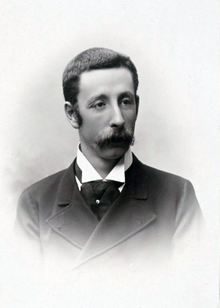Ivar Bendixson
Ivar Otto Bendixson (born August 1, 1861 in Stockholm ; † November 29, 1935 there ) was a Swedish mathematician.
Life
Bendixson went to school in Stockholm and studied from 1878 at the Royal Technical University of Stockholm and from 1879 at Uppsala University , where he made his diploma in 1881. He then became a student at Stockholm University, which had just been founded in 1880, and after his doctorate in Uppsala in 1890, assistant at Stockholm University and from 1892 at the Technical University. In 1900 he became professor of mathematics there and in 1905 professor at the university, of which he was rector from 1911 to 1927.
In 1887 he married a banker's daughter.
Act
Bendixson first worked on Georg Cantor's set theory , in which, among other things, he gave an example for an everywhere non- connected perfect set and proved that every uncountable closed set can be broken down into a perfect set and a countable set (Cantor's theorem -Bendixson).
Today he is best known for the Poincaré-Bendixson theorem about the behavior of solution curves of ordinary first-order autonomous differential equations (which describe the time flow of dynamic systems in Poincaré's original investigations) in two dimensions near a singular point. Either the curve ends at the singular point (sources, sinks) or there is a limit cycle (the solution curve circles the singular point). Bendixson gave his proof in 1901 independently of Poincaré, who had considered the special case of polynomial vector fields.
He also examined periodic solutions of differential equations using the method of continued fractions . In the theory of algebraic equations, he used Niels Henrik Abel's original methods (excluding the methods of Galois group theory) to explicitly determine the equations whose solutions can be expressed by radicals (operations of extraction of the roots) (Abel had fifth in the case of the equation Degree showed that this is not always possible).
literature
- Ivar Bendixson . In: Bernhard Meijer (Ed.): Nordisk familjebok konversationslexikon och realencyklopedi . 2nd Edition. tape 2 : Armatoler – Bergsund . Nordisk familjeboks förlag, Stockholm 1904, Sp. 1324 (Swedish, runeberg.org ).
Web links
- John J. O'Connor, Edmund F. Robertson : Ivar Bendixson. In: MacTutor History of Mathematics archive .
Remarks
- ↑ closed without isolated points, that is, every point of the set is an accumulation point
- ↑ Sur les courbes definitions par des equations differentielles. In: Acta Mathematica , Volume 24, pp. 1-88
| personal data | |
|---|---|
| SURNAME | Bendixson, Ivar |
| ALTERNATIVE NAMES | Bendixson, Ivar Otto |
| BRIEF DESCRIPTION | Swedish mathematician |
| DATE OF BIRTH | August 1, 1861 |
| PLACE OF BIRTH | Stockholm |
| DATE OF DEATH | November 29, 1935 |
| Place of death | Stockholm |
